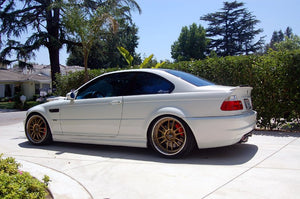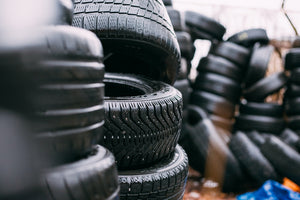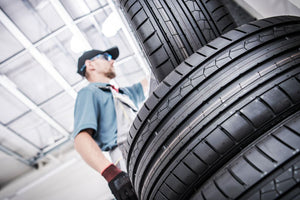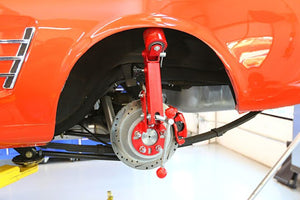
An Asian Influence: Best Cast Wheels for Tuners
When people think of high-performance Japanese cars, the Supra, GTR, Impreza, and Lancer Evo usually come to mind. These cars enjoy icon status because of their JDM heritage. This article will explore some of the best cast wheels to match them like Enkei, Rotiform, Raceline, and Vors Wheels.
Of Showcars and Street Cred

One of the first things you need to consider is your budget. You don’t want your build to be shortchanged just because you skimped on tuner wheels.
Wheels — while perhaps one of the most important parts of your vehicle — are only one of many upgrades you’ll need to buy to make your car shine. That’s why your budget should be properly split up among your top mods – paint/wrap, aero components, and finally, wheel and tire combos.

Now, to give you a better understanding of what’s available, and hopefully within your price range, here are some of the best cast wheels for tuners you can purchase for under $2000:
Vors Wheels LP1

Starts at $944 for a set of 4
The Vors LP1 is a textbook example of an aftermarket wheel design. It’s a split five-spoke wheel that is offered in eye-catching finishes, such as candy red and gold. That amount of personalization makes the LP1 appeal to many different buyers.
The LP1 is also a very universal design, in that it fits on normal vehicles like the Volkswagen Jetta or the Ford Focus. Because of its symmetry and architecture, it lends itself well to cars built in the 2000s and 2010s, but perhaps not cars from the ‘80s and ‘90s.
This wheel is available in 18 inches with a width option of 8.5 and 9.5 inches. With prices for the single color and custom colored versions well within reach of the average enthusiast, the LP1 is a great wheel choice for the builder looking to make a big statement (even if their bank statement is modest by comparison).
__
Klutch Wheels SLC3

Starts at $1,600 per set of 4
The Klutch SLC3 looks like a classic five-spoke wheel at first glance. But the model goes beyond the well-loved design.
The wheel face is set within an inner lip that has the Klutch signature slots. These elements set the SLC3 apart from the conventional versions.
It comes in 20” options and your choice of standard or custom finishes.

__
Rotiform Wheels R112 BLQ

Starts at $1,000 for a set of 4
The R112 BLQ wheel has a multi-spoke mesh design that evokes the spoke wheels of early automobiles, like the old E-Type Jaguar. This modern take on that design is currently trending, and it’s considered much more luxurious today and gives off a VIP vibe.
Because the R112 BLQ comes in Matte Black, it’s easy to repaint in any color or use as some crazy canvas. Plus, the mesh-inspired design of the R112 makes it stand out, regardless of the color you choose.
__
Radi8 Wheels R8B12

Starts at $1,056 for a set of 4
This floral-patterned wheel is another set of wheels fit for a VIP. Looking their best among the glittering lights of a club entrance, this wheelset screams, “I have arrived!”
And since they look their best fitted to European luxury cars, which are by nature among the most glamorous in the world, the wheels are tailor-made to show off.
Although the R8B12 in Matte Black may seem affordable compared to other brands, be warned. These are designed to look best in larger wheel diameters - 20 inches at least.
For this reason, it’s common for drivers to accidentally scrape them in a deep pothole, or grind them on a curb. So, they tend to have a shorter lifespan than smaller wheels.
Still, that doesn’t make them any less appealing.
__
ESR CR5

Starts at $1,140 for a set of 4
The ESR CR5 is a modern take on the timeless five-spoke wheel.
Five-spoke designs have become widely appreciated in the community, and these “fat five” designs are even more popular because they closely resemble racing designs of old.
Those looking for a universally pleasing design will probably like this wheel in bronze, though the black and silver wheels allow for a fast, new color repaint.
__
F1R F103

Starts at $920 for a set of 4
The F1R F103 is a good fit for someone who may be on a budget but who also wants to show off. The wheel design emulates designs of more expensive, high-end brands; yet it offers the same elegant design at a very attractive price point.
For catching attention at the local car meet, the F103 is definitely a good option, no matter what you drive - as long as it’s not a Yugo.
__
Motegi Wheels MR139

Starts at $700 for a set of 4
The Motegi MR139 is a wheel that mimics the design of rally wheels, both old and new. With a multi-spoke, wide center design, it’s a wheel that fits best in vehicles with rallying heritage, such as Imprezas and Evos.
Still, this design might not be for everyone. It’s clearly a copy of a rally car, which may not be the look every enthusiast wants to emulate. These wheels do, however, bring the rallying style to a highly affordable price point.
__
The Performance-Driven Tuners
If you've been in the car scene for a good number of years, you might be wondering why JDM cars underwent such a dramatic shift in aesthetics.
From chrome tear graphics and bulky body kits, JDM builders went with simple graphics and body mods that have both form and function. The answer is simple: As young car enthusiasts got older, they delved deeper into the JDM culture. They start appreciating performance a little bit more.
Enkei Wheels Compe

Starts at $640 for a set of 4
The Enkei Compe is a classic racing wheel design perfected over the years to really deliver on and off the track.
While it only weighs 16.3lbs, it’s a very stable wheel design because of its 8 spokes. It’s also a classic design that pays homage to Enkei’s original Compe wheels, which best fit on classic race cars.
They’re also reasonably priced and suit weekend-racer Japanese cars, like the EF Honda Civic, or an NA Miata. For these cars, 15 to 16-inch wheels sound just about right in terms of fitment. After all, you don’t want to run on a thin tire profile on the track.
__
Enkei RPF1
Starts at $1,020 for a set of 4
The Enkei RPF1 is a popular racing wheel because of its lightweight properties. At grassroots motorsport events, you can find these wheels on everything from FWD Civics to AWD Imprezas.
The RPF1 is a direct descendant of Enkei’s Formula 1 racing wheels, which is probably another reason for their popularity. With most sizes weighing less than 10 lbs, it’s no surprise that these wheels are the darling of the racing world.
__
Kansei KNP

Starts at $1200 per set of 4
The Kansei KNP is the kind of wheel that will look good on just about any tuner. Its classic look takes inspiration from time-tested designs used on the street and track.
The clean five spokes is the perfect example of less is more. The KNP can make a big statement without the need for an elaborate design.
Its sturdy and lightweight construction also makes an affordable option should you want to go on a track day. This wheel comes in 17- and 18-inch options.

__
MST MT30

Starts at $800 for a set of 4
The MST MT30 is a lightweight option that every racer should consider.
Weighing in at about 21 lbs a wheel and costing less than a thousand dollars for a set of four, the MT30 is a high spec wheel with a reasonable price. And that’s all any beginner racer really needs: a sturdy wheel that is cheap to replace.
__
Japanese Cars Then and Now
Japanese cars have gone a long way in influencing the car community stateside. Let’s have a look at how it came to be:
Turning Japanese

In the ‘80s and ‘90s, the Japanese Domestic Market was saturated with all the latest available technology – car phones, navigation, and other modern comforts we take for granted today.
This tech craze occurred during the horsepower wars (when race car manufacturers literally tried to outmuscle one another). At this time, automakers like Nissan, Honda, Mazda, Mitsubishi, and Toyota took full advantage of the technology available to them.
Like a Great Wave
Introducing — or simply implementing — new auto innovations, such as twin-turbos, all-wheel-drive systems, and four-wheel steering. Japanese car companies capitalized on the dramatic technological developments occurring in the industry.
These high-performance Japanese monsters devoured their competition. Not only were cars like the JTCC and Super GT racing series superior to their rival race cars (mechanically speaking), they dominated the world stage as well.
Mitsubishi, Subaru, and Toyota turned the rally world on its head when their cars started winning rally stages and championships - thanks to their superior technology.
Nissan dominated Australian touring cars with the R32 Skyline. Its 300ZX sports car also became a legend in IMSA racing.

Mazda and Honda, not to be outdone, found success in Le Mans and Formula 1, respectively. The latter even managed to employ the late, great Ayrton Senna.

That partnership paved the way for probably the most recognizable footwork video ever – Ayrton Senna taking a Honda NSX to its absolute limit around a track while wearing loafers.
Sitting in the passenger seat for that ride would probably be as close as a car enthusiast could get to Petrol Heaven.
The Midnight Club

After falling down the rabbit hole of Supercar Wonderland, they landed in the midst of a rowdy group of racers called the Midnight Club. Its members were street racing heroes, driving their high-performance cars through Tokyo highways, sustaining speeds above 190 mph (at a time when most production cars could only reach this maximum velocity for a few seconds).

Thirty years after disbanding, these racers, whose identities remain a heavily guarded secret to this day, became the inspiration for the Wangan Midnight anime series and a live-action movie. It goes without saying that their influence still shows in the street builds we see today, especially with the wheel choices.
All-American JDM

It’s this performance craze that made JDM cars the darling of the early 2000s movie franchise The Fast and the Furious.
These films were based on the real tuner scene, that is, prior to later installments of the film series when the characters started driving these cars off planes. They brought Japanese cars into a prominent position on the silver screen.

Cars like the Integra Type R, RX-7, and Supra became dream cars for many young enthusiasts who watched those movies.
Those Dubs Though

The trend in the early 2000s was to go loud and proud with large chrome dubs. Today enthusiasts trade chrome spinners and bling for something “lit”.
If the term “lit” makes no sense to you, that’s okay. But if you weren’t around when spinners and bling became a hit, consider yourself lucky. Those were some dark times in the car scene.

And while those older than 21 look back at these cars with nostalgia in their eyes, it’s only because no one admits those mods made absolutely no sense.
Thankfully, the tuner scene has since moved on to more subdued, detail-oriented designs. In place of chrome dubs are tastefully painted cast wheels and it comes with good reason.
Hoonigan Racing

More recently, the guys at Hoonigan Racing Division have taken the JDM scene by storm. Their driving styles are rooted in Asian influences, most notably drifting.
Drivers Ken Block and Travis Pastrana rip up the track and take down the competition in their modified cars, driving in the most unorthodox racing venues imaginable — aircraft graveyards, closed city streets, and other tracks off the beaten path.

From racetracks to parking lots, it’s impossible to go to any event without seeing at least five GTRs, five STIs, and at least one Evo X.
As a result, car enthusiasts are currently purchasing the same aftermarket wheels championed by their car heroes - racers, rally drivers, and high-level tuners.
Race-Themed Builds

Racecars and show cars are very different vehicles: and these two types of cars require dramatically different kinds of wheels. For example, race car manufacturers aim to build light wheels — as lighter weight means less rotating mass on the track. This translates into better acceleration.
Less wheel weight also means less unsprung weight, which makes suspension tuning easier; this, in turn, makes the behavior of the car’s suspension more predictable.

Racecar builders also need to think about how much it costs to replace each wheel, especially considering the short lifespan of each racing wheel. Every time a racer bends or cracks a wheel while driving on a track, a new wheel must be waiting on deck.
Therefore, the track-oriented builder focuses on the spec of the wheel, rather than the aesthetic. They follow the “function over form” ethos for their track cars. These technicians want the fastest, most powerful, and most durable racing machines possible.
Racecar builders prefer subdued designs and muted colors. This is because black wheels are usually cheaper and non-reflective. Dull colors also won’t cause glare on the track and blind a driver temporarily.

With that said, aesthetics are still important for race car builders. The flashiest driver is usually a memorable one, and it never hurts to look good when you’re fighting for pole position. It helps that in most grassroots motorsports, restrictions are usually lenient. This gives the driver more freedom to choose whatever wheels they want.
__
Choosing Tuner Wheels by Purpose

One thing we’ve tried to convey in this article is that the tuner wheel you choose will be determined by the application you have in mind.
If you’re building your car to cruise down Woodward Avenue or park up next to your friends at the local car meet, then the weight of your wheels probably doesn’t rank very high on your list of priorities. Certainly, street cred takes precedence over seconds shaved off your speed in this situation.

If you’re building your car to chase down Porsche GT3 RS’s and Huracan Performantes on the track, then first off, kudos to you man, you’ve got guts.
But if you’re that dedicated to knocking down those lap times, then you know how important the right set of lightweight wheels can be. You know it’s the difference between being one second ahead, or being half a second behind. It’s the difference between winning or losing the race.
The same goes for durability. The meaning of the word differs for each person.

For the track nut, it means that my wheels can take the punishment of repeated heat cycles from heavy braking and shearing force from aggressive cornering? Can it withstand the torque of a holeshot from a 750 horsepower V8 Camaro? These are all questions track guys need to ask themselves before deciding on a set of wheels.
For the street scene, the word durability means something almost entirely different. Yes, your wheels need to withstand heat and torque, but more importantly, how easily can you repair them if they get curb rash? Can standard polish remove chips and scratches?
How resistant are the wheels to rust from salted icy roads? Well honestly, that last question isn’t exactly a dealbreaker, because we know your cars don’t leave the garage in winter; but the question should pique the interest of enthusiasts in certain northern states.
The idea here is to think about what you’re building your car for and to pick an appropriate set of wheels for that purpose. The decision is yours, my friend. Embrace the variety, and embrace your individuality.

__
The Value of Choosing Cast Wheels
Cast wheels are the practical go-to upgrades for most enthusiasts. These are formed by superheating aluminum and pouring the liquid aluminum into a mold.
This process makes it relatively inexpensive to produce cast wheels. It also allows manufacturers to sell their wheels to a wider range of enthusiasts.
Thanks to changing techniques in casting, new wheels are stronger than their counterparts from at least 20 years ago. This makes the whole process more refined, and thereby makes the wheels a better value, if not cheaper.
Another advantage of cast wheels is that they give the consumer more choice. Because they come “pre-assembled,” it’s simply a matter of choosing the design, color, and proper fitment for your vehicle.
__
Stand Out and Have Fun!
For the tuner scene, it’s all about standing out with your build, and the same goes for choosing your wheels. The first thing on the builder’s mind when choosing a wheel is how it will be received at the next Cars & Coffee. The wheel design should turn heads.

In other words, the wheel design needs to be recognizable and unique. An observer should look at the wheel and think to themselves, “Wow, I never thought a wheel design could look cool, and be affordable!”
Another big part of making a car beautiful is choosing the best finish for your wheels. What sartorial humbug dictated that you could only choose drab greys and blacks?
The wheel should shine with unexpected hues, perhaps of purple or red, or any other color that can express your personality and highlight your car.
One of the most amazing things about the car community now is the widespread appreciation for finishes of all different shades. One can choose a hot pink set of wheels for a black Subaru, and it would look as appropriate at a car meet as a black set of wheels on the same car.
This appreciation of uniqueness and variety is one of the best aspects of the car community.



















